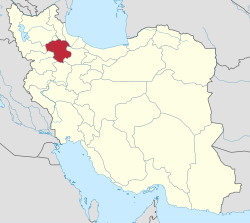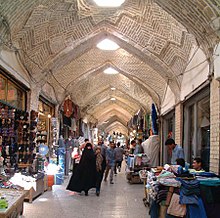
Tehran province is one of the 31 provinces of Iran. Its capital is the city of Tehran. It covers an area of 18,814 square kilometres (7,264 sq mi) and is located to the north of the central plateau of Iran.
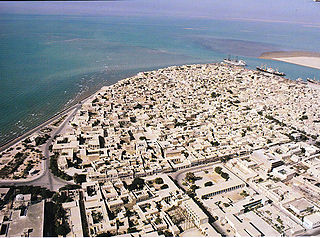
Bushehr province is one of the 31 provinces of Iran. It is in the south of the country, with a long coastline on the Persian Gulf. Its capital is the city of Bushehr.

Qazvin province is one of the 31 provinces of Iran. It is in the northwest of the country, with the city of Qazvin as its capital. The province was carved out of Tehran province in 1993.

Qom province is one of the 31 provinces of Iran with 11,237 km², covering 0.89% of the total area of the country. Its capital is the city of Qom. The province is in the central part of the country and was formed from part of Tehran province in 1995.

Agha Mohammad Khan Qajar, also known by his regnal name of Agha Mohammad Shah, was the founder of the Qajar dynasty of Iran, ruling from 1789 to 1797 as Shah. Originally a chieftain of the Quwanlu branch of the Qajar tribe, Agha Mohammad Khan was enthroned as the king of Iran in 1789, but was not officially crowned until March 1796, having deposed Lotf Ali Khan of the Zand dynasty in 1794. Agha Mohammad Khan Qajar was famously the eunuch Monarch, being castrated as a toddler upon his capture by Adel Shah Afshar, and hence was childless. He was assassinated on 17 June 1797, and was succeeded by his nephew, Fath-Ali Shah Qajar.

The Zand dynasty was an Iranian dynasty, founded by Karim Khan Zand that initially ruled southern and central Iran in the 18th century. It later quickly came to expand to include much of the rest of contemporary Iran as well as parts of Iraq. The lands of present-day Armenia, Azerbaijan, and Georgia were controlled by khanates which were de jure part of the Zand realm, but the region was de facto autonomous. The island of Bahrain was also held for the Zands by the autonomous Al-Mazkur sheikhdom of Bushire.

The Karabakh Khanate was a khanate under Iranian and later Russian suzerainty, which controlled the historical region of Karabakh, now divided between modern-day Armenia and Azerbaijan. In terms of structure, the Karabakh Khanate was a miniature version of Iranian kingship. The administrative and literary language in Karabakh until the end of the 19th century was Persian, with Arabic being used only for religious studies, despite the fact that most of the Muslims in the region spoke a Turkic dialect.

Zanjan is a city in the Central District of Zanjan County, Zanjan province, Iran, serving as capital of the province, the county, and the district.

Shirvan Khanate was a Caucasian khanate under Iranian suzerainty, which controlled the Shirvan region from 1761 to 1820.
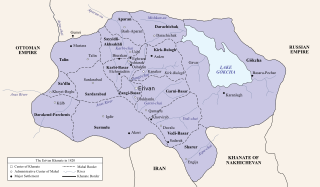
The Erivan Khanate, also known as Chokhur-e Sa'd, was a khanate that was established in Afsharid Iran in the 18th century. It covered an area of roughly 19,500 km2, and corresponded to most of present-day central Armenia, the Iğdır Province and the Kars Province's Kağızman district in present-day Turkey and the Sharur and Sadarak districts of the Nakhchivan Autonomous Republic of present-day Azerbaijan.
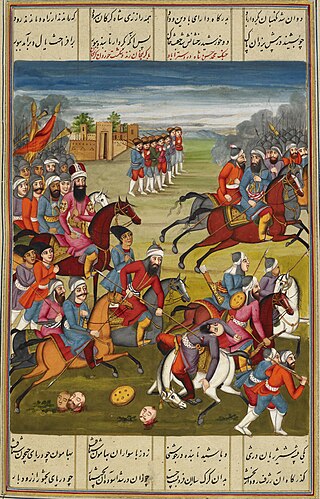
Mohammad Hasan Khan Qajar, also spelled Muhammad and Hassan (1715–1759), chief of the Qoyunlu branch of the Qajar tribe of Turkomans in the Caspian coastlands around Astarabad, was the son of Fath Ali Khan and the father of Agha Mohammad Khan Qajar, who founded the Qajar dynasty of Iran.
Azād Khān Afghān, or Azād Shāh Afghān, was a Pashtun military commander and a major contender for supremacy in western Iran after the death of Nader Shah Afshar in 1747. Azad rose to power between 1752 and 1757, and had his power base in the Azarbaijan region. Azad was a contemporary of Ahmad Shah Durrani, the founder of the Durrani Empire.
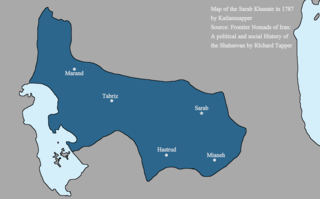
The Sarab Khanate was a Kurdish khanate centered around Sarab from 1747 and ruled by the Shaqaqi tribe.
Fath-Ali Khan Afshar, was a chieftain from the Afshar tribe of Urmia, and one of the four contenders for supremacy in Iran between 1751–1763. He was ultimately defeated and captured in February 1763 by one of the contenders, the Zand ruler Karim Khan Zand. The latter had Fath-Ali Khan executed the following year, in July 1764.

Hajji Ebrahim Shirazi, also known by his honorific title E'temad ol-Dowleh, was an Iranian statesman who served as the kalantar of the city of Shiraz during the late Zand era and later as the first grand vizier of Qajar Iran.

The Tabriz Khanate was a Caucasian Khanate from 1757 to 1799, centered around Tabriz and led by members of the Turkified Kurdish Donboli tribe.
The Khoy Khanate, also known as the Principality of Donboli, was a hereditary Kurdish khanate around Khoy and Salmas in Iran ruled by the Donboli tribe from 1210 until 1799. The khanate has been described as the most powerful khanate in the region during the second half of the 18th century. The official religion of this principality was originally Yezidism, until some rulers eventually converted to Islam. The principality has its origins under the Ayyubid dynasty and was ultimately dissolved in 1799 by Abbas Mirza. During this period, the status of principality oscillated between autonomous and independent.

Hossein Qoli Khan Qajar was the Qajar chieftain of the Qoyunlu branch from 1759 till his death in 1777 and brother of the founder of the Qajar dynasty of Iran Agha Mohammad Khan Qajar.

Afsharid Iran, also referred as the Afsharid Empire, was an Iranian empire established by the Turkoman Afshar tribe in Iran's north-eastern province of Khorasan, establishing the Afsharid dynasty that would rule over Iran during the mid-eighteenth century. The dynasty's founder, Nader Shah, was a successful military commander who deposed the last member of the Safavid dynasty in 1736, and proclaimed himself Shah.

Abdollah Mirza Qajar was an Iranian prince (shahzadeh) of the Qajar dynasty, the 11th son of Fath-Ali Shah, king of Qajar Iran from 1797 to 1834. Abdollah was the governor of Zanjan. He had two children, Mohsen Mirza and Shams al-Molok, with his wife. Other than that, he had 19 sons and 9 daughters from his concubines.
